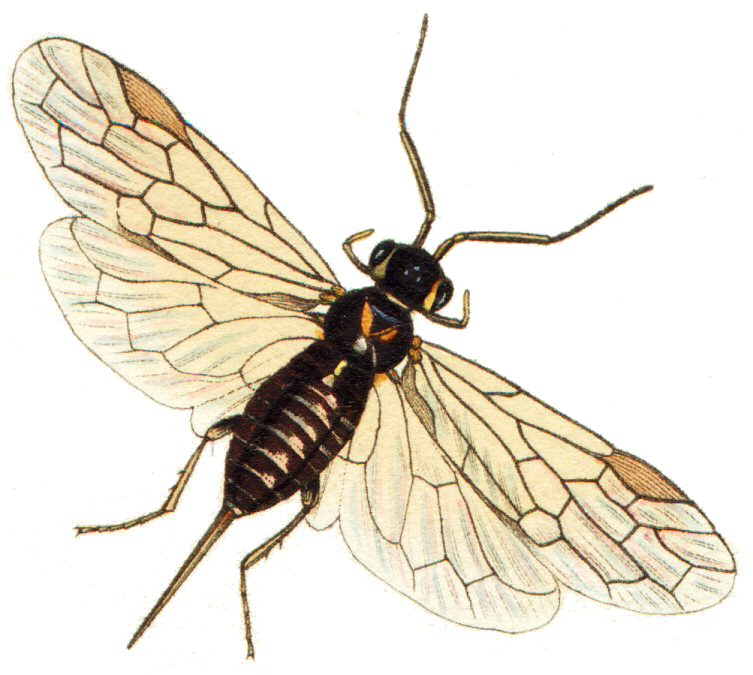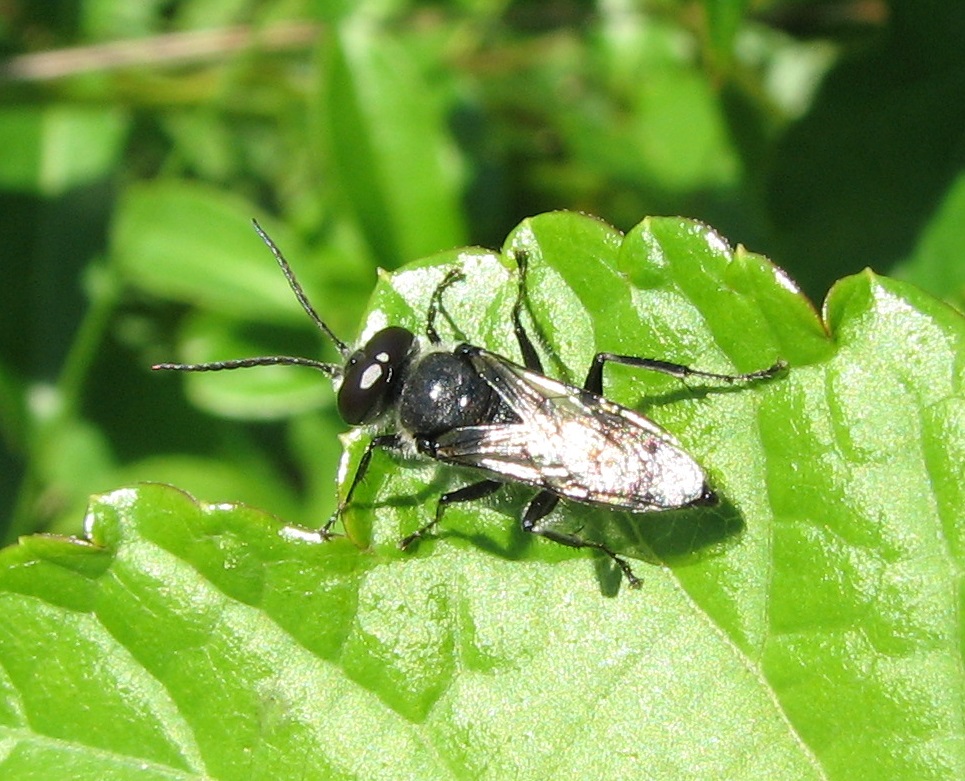|
Megalyridae
Megalyroidea is a small hymenopteran superfamily of wasps that includes a single family, Megalyridae, with eight extant genera (plus around a dozen extinct ones) and 49 described species. Modern megalyrids are found primarily in the southern hemisphere, though fossils have only been found in the northern hemisphere. The most abundant and species-rich megalyrid fauna is in Australia. Another peak of diversity appears to be in the relict forests of Madagascar, but most of these species are still undescribed. Historically, there has been much confusion about the definition of this family. Species now placed in Megalyridae have in the past been classified into as many as six other families ( Braconidae, Evaniidae, Ichneumonidae, and Stephanidae, as well as Dinapsidae and Maimetshidae, with Dinapsidae now considered to be within the Megalyridae. Maimetshidae is no longer considered closely related to Megalyridae, and has been included in Trigonaloidea with Trigonalidae. The oldes ... [...More Info...] [...Related Items...] OR: [Wikipedia] [Google] [Baidu] |
Apocrita
Apocrita is a suborder of insects in the order Hymenoptera. It includes wasps, bees, and ants, and consists of many families. It contains the most advanced hymenopterans and is distinguished from Symphyta by the narrow "waist" ( petiole) formed between the first two segments of the actual abdomen; the first abdominal segment is fused to the thorax, and is called the propodeum. Therefore, it is general practice, when discussing the body of an apocritan in a technical sense, to refer to the mesosoma and metasoma (or gaster) rather than the "thorax" and "abdomen", respectively. The evolution of a constricted waist was an important adaption for the parasitoid lifestyle of the ancestral apocritan, allowing more maneuverability of the female's ovipositor. The ovipositor either extends freely or is retracted, and may be developed into a stinger for both defense and paralyzing prey. Larvae are legless and blind, and either feed inside a host (plant or animal) or in a nest cell provi ... [...More Info...] [...Related Items...] OR: [Wikipedia] [Google] [Baidu] |
Maimetshidae
Maimetshidae is an extinct family of wasps, known from the Cretaceous period.M. S. Engel. 2016A new genus and species of maimetshid wasps in Lebanese Early Cretaceous amber (Hymenoptera: Maimetshidae).''Novitates Paleoentomologicae'' 18:1-14 While originally considered relatives of Megalyridae, they are now considered to probably be close relatives of Trigonalidae. Subdivisions * Subfamily † Maimetshinae Rasnitsyn 1975 ** Tribe † Ahiromaimetshini Engel 2016 ***'' Ahiromaimetsha'' Perrichot et al. 2011 Lebanese amber, Early Cretaceous (Barremian) ***'' Turgonaliscus'' Engel 2016 Weald Clay, United Kingdom, Early Cretaceous (Barremian) ***'' Turgonalus'' Rasnitsyn 1990 Turga Formation, Zabaykalsky Krai, Russia, Early Cretaceous (Aptian) ** Tribe † Maimetshini Rasnitsyn 1975 ***'' Afrapia'' Rasnitsyn and Brothers 2009 Orapa, Botswana, Late Cretaceous (Turonian) ***'' Afromaimetsha'' Rasnitsyn and Brothers 2009 Orapa, Botswana, Late Cretaceous (Turonian) ***'' Ahstemiam'' McKe ... [...More Info...] [...Related Items...] OR: [Wikipedia] [Google] [Baidu] |
Ovipositor
The ovipositor is a tube-like organ used by some animals, especially insects, for the laying of eggs. In insects, an ovipositor consists of a maximum of three pairs of appendages. The details and morphology of the ovipositor vary, but typically its form is adapted to functions such as preparing a place for the egg, transmitting the egg, and then placing it properly. For most insects, the organ is used merely to attach the egg to some surface, but for many parasitic species (primarily in wasps and other Hymenoptera), it is a piercing organ as well. Some ovipositors only retract partly when not in use, and the basal part that sticks out is known as the scape, or more specifically oviscape, the word ''scape'' deriving from the Latin word '' scāpus'', meaning "stalk" or "shaft". In insects Grasshoppers use their ovipositors to force a burrow into the earth to receive the eggs. Cicadas pierce the wood of twigs with their ovipositors to insert the eggs. Sawflies slit t ... [...More Info...] [...Related Items...] OR: [Wikipedia] [Google] [Baidu] |
Crabronidae
The Crabronidae are a large paraphyletic group (nominally a family) of wasps, including nearly all of the species formerly comprising the now-defunct superfamily Sphecoidea. It collectively includes well over 200 genera, containing well over 9000 species. Crabronids were originally a part of Sphecidae, but the latter name is now restricted to a separate family based on what was once the subfamily Sphecinae. Several of the subfamilies of Crabronidae are often treated as families in their own right, as is true of the most recent phylogenies (example below). Phylogeny This phylogenetic tree is based on Sann ''et al.'', 2018, which used phylogenomics to demonstrate that both the bees (Anthophila) and the Sphecidae arose from within the former Crabronidae, which is therefore paraphyletic, and which they suggested should be split into several families; the former family Heterogynaidae nests within the Bembicidae, as here defined. These findings differ in several details from st ... [...More Info...] [...Related Items...] OR: [Wikipedia] [Google] [Baidu] |


